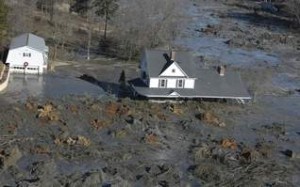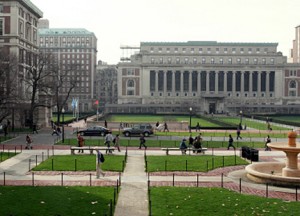NY. Jan. 25. Mark Fulton, “Climate Change Strategist” Deutsche BankAsset Management, spoke at Cary Krosinsky’s class in Sustainable Investing at the CERC, the Center for Environmental Research and Conservation, Earth Institute, Columbia University.
Krosinsky, Vice President of Trucost, recently co-edited and wrote the book Sustainable Investing: The Art of Long Term Performance with Nick Robins of HSBC. He is an Advisory Board member of the Association of Climate Change Officers (ACCO) and founder director of InvestorWatch. Trucost has built and maintains the world’s largest database of carbon emissions and other environmental impacts as generated by the world’s largest public and private companies. Their data and expertise is used by leading global fund managers and asset owners to manage carbon risk.
Krosinsky described Climate Change and Global Warming in terms of Pascal’s Wager. “We can neither prove nor disprove that God exists. However, if we act as if God exists we will be better off.” So it is with climate change. The science is complex. But we will be better off if we redesign our energy and industrial infrastructures, reduce the level of greenhouse gases, and build a sustainable infrastructure.
Rather than subsidizing coal, oil, gas, and nuclear power, we need to tax carbon. And use the money to build solar arrays, wind turbines, and other new things.
“When you listen to the State of the Union,” Fulton said, “don’t expect anything on cap and trade, but expect to hear about green jobs.”
“Every time there’s a crisis,” he added, “we rediscover John Maynard Keynes and the government stimulates the economy.”
“Peak Oil,” Fulton said, the idea that extraction of oil has peaked, “appears to be borne out by the market. When oil prices were high ($140 per barrel) OPEC wasn’t producing more oil – they couldn’t.”
But in my opinion, this isn’t a bad thing. As oil and other fossil fuels get more expensive we will shift to other, sustainable technologies. I’ve been thinking about the science. We’re 25 to 30 years away from Fusion. (Click here for the MIT Press Release summarizing work at the MIT and Columbia on the Levitated Dipole Experiment, LDX).
The science on climate change can be summarized:
We’ve put 3.6 trillion tons of carbon dioxide into the atmosphere in the last 200 years – mostly in the last 50. We’ve changed the concentration of Carbon Dioxide from 250 ppm to 390 ppm – an increase of 56%. Carbon dioxide is not meteorologicaly active. This is changing the thermodynamic behavior of the atmosphere, the oceans, and the land surfaces – it’s changing the climate and the weather.For a concise description, see this article in Scientific American and my summary on Popular Logistics. For the details see William James Burroughs, Climate Change, A Multidisciplinary Approach. 2nd Edition, Cambridge, 2007, ISBN 978-0-521-87015-3 or 978-0-521-69033-1. As to why it took so long to figure it out, when Burroughs titled his book “A Multidisciplinary Approach” he wasn’t exagerating. You need to understand physics, including fluid dynamics and mechanics, chemistry, geology, ecology, evolutionary biology, paleontology, etc. You don’t need a PhD, but you need to be able to think.
Rather than framing the debate in terms of parts per million of carbon dioxide, like they do at 350.org, We Can Solve It, and elsewhere, Fulton uses Tons of Carbon Dioxide in the atmosphere – 3,651,546,689,564 – 3.6 trillion tons, increasing by 800 Metric Tons per second. One instance of the counter is on the Internet, here. Another is outside Madison Square Garden. And you can install a widget on your desktop by clicking here.
The people on Wall Street are interested in things they can quantify and hedge. They are more interested in natural gas, solar, and wind than coal. We know how to do wind, solar, and gas. Coal is dependent on Carbon Capture & Sequestration, CCS, which we don’t know how to do. We won’t know if we know how to do CCS for 20 or 30 years. Investors on Wall St. don’t want to get caught holding the bag. (This is also the problem with nuclear power. The plants can be operated more or less safely. But an accident like 3 Mile Island will turn a billion dollar investment into a 10 billion dollar pile of radioactive waste – in milliseconds.)

View of what had been the James home in the middle of 1.1 billion gallons of sludge, Copyright (c) 2008, Knoxville Biz . com
After the formal lecture, I asked Fulton about coal …
If you use the term “Clean Coal” you’ve never been to West Virginia. Michael Hendryx’ research that suggests that for every $1 in revenue from coal mining there is $5.25 in costs and premature deaths. Click here for an interview, here for an abstract of the research paper or here for my post on Popular Logistics.
On Dec. 22, 2008 1.1 billion gallons of coal ash flooded 300 acres and the Clinch and Tennessee Rivers, near Kingston, Tennessee. Click here for satellite photos and analysis from NASA, here for my post, “Clean Coal, My Ash”, or here for an account on Knoxville Biz.com.
Fulton, sounding like Herman Daly, Joshua Farley and other Ecological Economists said “in the future externalities will be internalized.”
And the good news for investors :
The Europeans have done a great job with PVSolar. The next big thing will be Concentrated Solar Thermal (CST).
Fulton and Krosinsky also noted that when socially responsible investing (SRI) started people expected to pay – to sacrifice a few dollars in return on investment for sleeping better at night. But they found that they did well by doing good. They stopped investing in tobacco companies, and they were not holding the bag when tobacco companies were sued. Out of a universe of 4000 equities, Fulton and his people identified about 100 in several sub-sectors: Global Clean Energy, Global Energy Efficiency, Clean Technology. These significantly outperformed the S&P since the recent bottom – March, ’09, in the last year, and in the last 3 years. Energy Efficiency was the best segment – it’s easier and cheaper to install insulation than solar arrays. There’s money to be made doing well by doing good.

